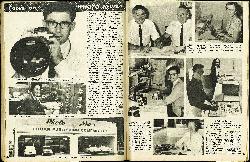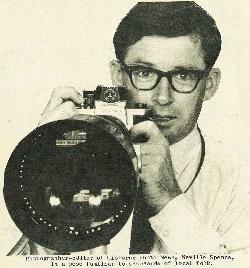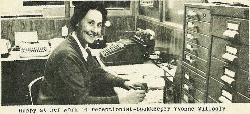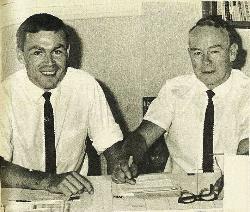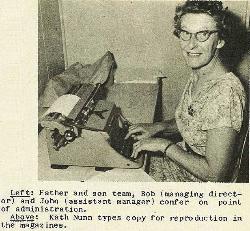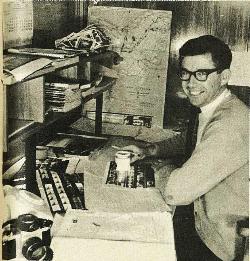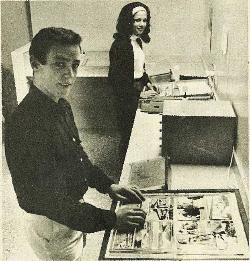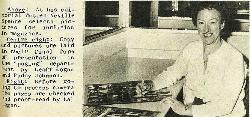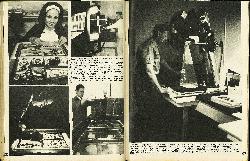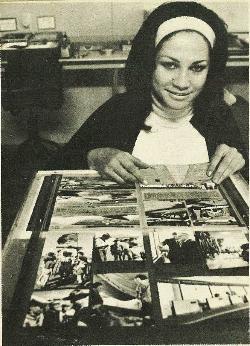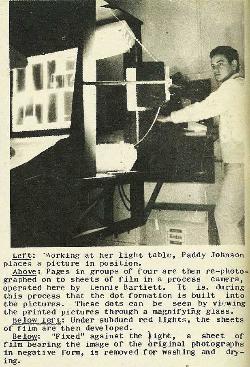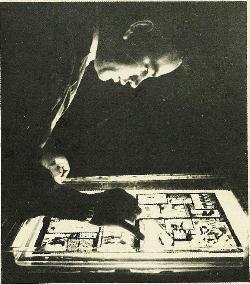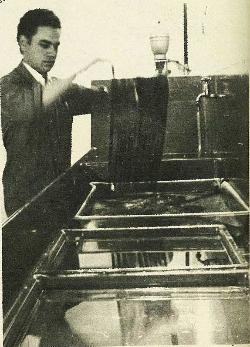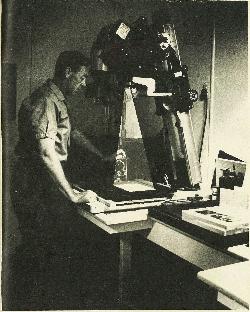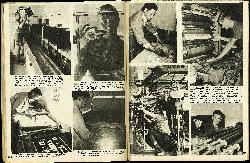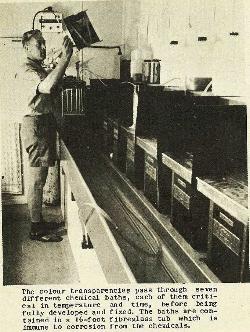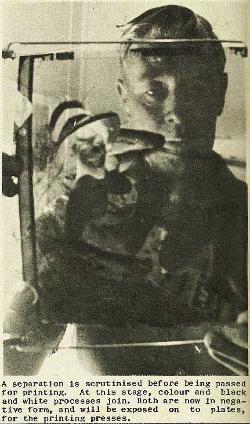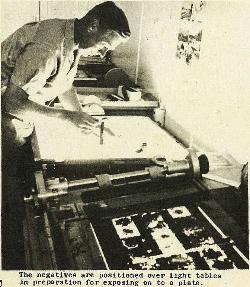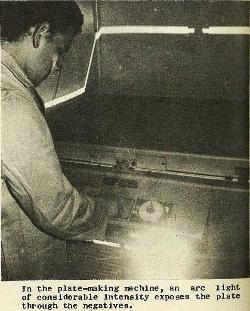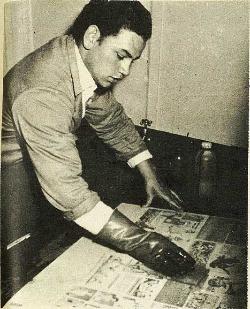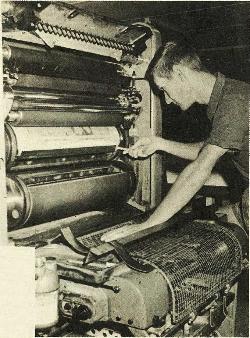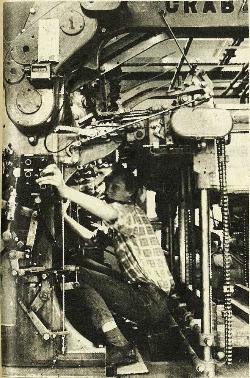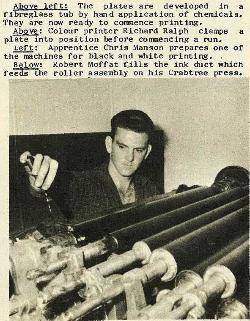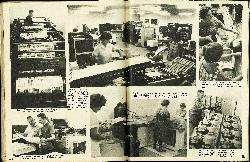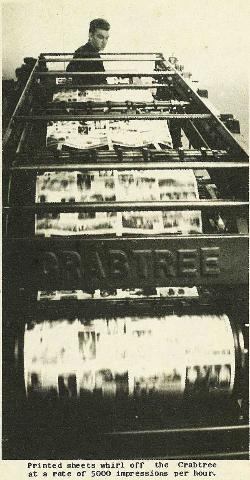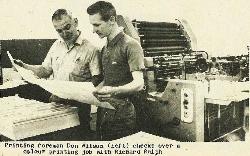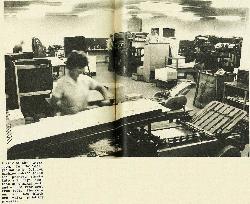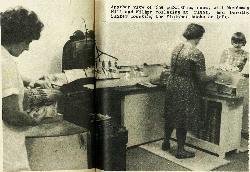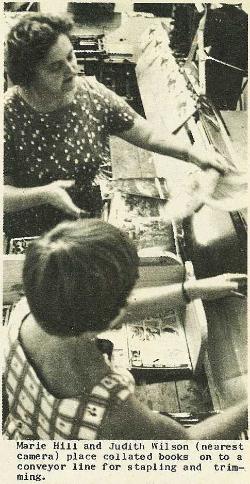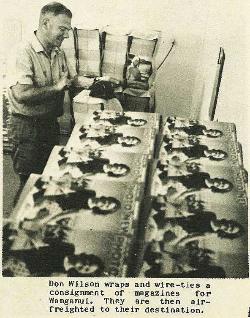66
Focus on "Photo News"
For many years people have been asking us to print something about the complex processes by which "Photo News" is produced. Now that we are installed in our new premises, perhaps the time is opportune to present this feature. We trust it will be of interest to all our readers.
Newer and younger readers of "Photo News" may not know that the magazine started 13 years ago in a couple of rooms behind a house in Aberdeen Road, with a staff of one. Now we print ten magazines and a growing volume of colour illustration work, employ a staff of 22, and our new premises occupy over 9,000 sq ft of modern offices, darkrooms, factory and store.
The interior of what used to be the Poverty Bay Garage in Derby Street has been completely transformed. The planning has been done to facilitate efficient production, working from the editorial rooms at the front of the building, through the typing, reading, page production and checking processes to the camera and platemaking departments, and then to the printing and publishing sections further back. About half of the interior, comprising photographic process and printing departments, has been equipped with fibreglass insulation and automatic temperature control.
Magazines are printed here for Gisborne, Whangarei, Tauranga, Rotorua, New Plymouth, Napier, Hamilton, Wanganui, Palmerston North and Nelson. Copy, pictures, and page plans flow in via NAC flights from all these centres for sub-editing, typing and preparation for the process camera. This converts them, four pages at a time, into 20" x 16" sheets of film, which are then printed down to sensitised aluminium printing plates, eight pages at a time. The plates are clamped into large offset litho presses for the actual printing process. The colour covers are printed on a smaller press.
67
Building Credits
The following contractors were responsible for the construction of the new "Photo News" premises in Derby Street:
Offices.....Craill & Morley Ltd.
Darkrooms, Factory, Workshop, Cafeteria, Washrooms, Insulation and Fittings.........J. Devenport
Electrical..Powell & Sexton Ltd.
Plumbing....Paulson & Sligo Ltd.
Flooring, Roofing.....R. D. Hovell
Situflex Floor.......Harry Alley
Drainlaying...........J. T. Hinaki
Carpets......Laskey Carpets Ltd.
Structural.....J. L. Primrose Ltd.
Painting..............George Fox
Bricklaying.............Ken Wood
Father and son team, Bob (managing director) and John (assistant manager) confer on point of administration.
Kath Nunn types copy for reproduction in the magazines.
At his editorial duties Neville Spence selects pictures for inclusion in magazine.
Copy and pictures are laid In their final form of presentation in the "paging" department by Geoff Logan and Paddy Johnson.
Before going to process camera the pages are checked and proof-read by Lal Logan.
68
Working at her light table, Paddy Johnson places a picture in position.
Pages in groups of four are then re-photographed on to sheets of film in a process camera, operated here by Lennie Bartlett. It is during this process that the dot formation is built into the pictures. These dots can be seen by viewing the printed pictures through a magnifying glass.
Under subdued red lights, the sheets of film are then developed.
"Fixed" against the light, a sheet of film bearing the image of the original photographs in negative form, is removed for washing and drying.
69
At this stage we will leave the processing of black and white pictures and visit Wilton Smith, our senior photo-lithographer, immersed in the depths of his darkroom exposing a set of transparency colour separations for a Photo News cover. Each colour picture is printed four times, with red, blue, yellow, and black inks, which combine together to give a full range of colour tones. The four negatives which determine the density of each ink required to produce the final colour are known as separations.
70
The colour transparencies pass through seven different chemical baths, each of them critical in temperature and time, before being fully developed and fixed. The baths are contained in a 16-foot fibreglass tub which is immune to corrosion from the chemicals.
A separation is scrutinised before being passed for printing. At this stage, colour and black and white processes join. Both are now in negative form, and will be exposed on to plates, for the printing presses.
The negatives are positioned over light tables in preparation for exposing on to a plate.
In the plate-making machine, an arc light of considerable intensity exposes the plate through the negatives.
71
The plates are developed in a fibreglass tub by hand application of chemicals. They are now ready to commence printing.
Colour printer Richard Ralph clamps a plate into position before commencing a run.
Apprentice Chris Manson prepares one of the machines for black and white printing.
Robert Moffat fills the ink duct which feeds the roller assembly on his Crabtree press.
72
Printed sheets whirl off the Crabtree at a rate of 5000 impressions per hour.
Printing foreman Don Wilson (left) checks over a colour printing job with Richard Ralph
A view of the press room. In the foreground is a folding machine (which folds the printed sheets into a 16 page section of a magazine), and at the rear are, from left, the colour and two black and white printing presses.
Another view of the publishing room, with Mesdames Hill and Wilson collating at right, and Dorothy Baxter counting the finished books at left.
73


